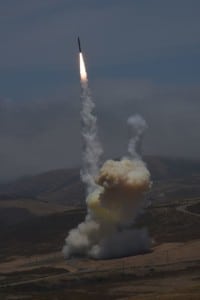Lockheed Martin [LMT] said it is teaming up with Aerojet Rocketdyne
[AJRD] in the competition for the Next Generation Interceptor (NGI) for the Missile Defense Agency’s (MDA) Ground-based Midcourse Defense (GMD) system.
The NGI program will replace the Redesigned Kill Vehicle (RKV) that the Defense Department canceled in 2019 year due to technical issues causing significant schedule and cost increases (Defense Daily, Aug. 21).

Lockheed Martin initially confirmed it put in a bid for NGI in August when it said it is using a ‘fly before you buy’ mentality and planned to fly two successful intercepts before moving into production (Defense Daily, Aug. 4).
At the time the company said it will leverage its current missile defense and space programs like the Aegis Combat System, Terminal High Altitude Area Defense (THAAD) program, and role as a partner in the Navy’s Trident II D-5 ballistic missile with its space division.
Now the company argued its interceptor is being designed from the ground up to address “all elements of environmental survivability from day one” while Aerojet Rocketdyne is set to power the primary propulsion system.
“We support the MDA’s vision for NGI, particularly in light of the Redesigned Kill Vehicle termination and a fast-moving threat environment. Evolution of our deployed Ground-Based Midcourse Defense (GMD) system to defend the homeland is critical,” Sarah Reeves, vice president of missile defense programs at Lockheed Martin, said in a statement.
“The strength of our team comes from an understanding of how to design and sustain radiation hardened strategic systems, the application of advanced digital engineering, and unmatched hit-to-kill performance,” she added.
“Aerojet Rocketdyne has provided propulsion on the Ground-Based Midcourse Defense system since its inception, and we’re pleased to partner with Lockheed Martin on this next generation opportunity,” Eileen Drake, Aerojet Rocketdyne CEO and president, added.
Lockheed Martin did not name other members of its team but said it will disclose “the full composition of the NGI team in the near term.” It did note the team includes both GMD incumbents and technology leaders “best suited to deliver on this never-fail mission.”
Aerojet Rocketdyne is also part of the Boeing [BA] team that includes General Atomics and Northrop Grumman [NOC], where it is set to provide the propulsion system on that bid as well (Defense Daily, Sept. 24).
Boeing previously served as the prime contractor for the RKV while Raytheon Technologies [RTX] was the subcontractor developing the specific interceptor.
MDA released the NGI Request for Proposals in April with the intent of awarding two contracts for simultaneous development of NGI options through at least the critical design period. Later in development the agency plans to downselect to one design (Defense Daily, April 24).
MDA said it expects the total cost of designing, developing and fielding the total planned 20 NGIs to be over $11 billion. Testing is expected to start in 2025-26 and interceptors could start being placed n silos as soon as 2027-28.